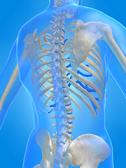Advertisment
Predictors of postpartum pelvic joint pain identified among working women

First report of unexplained pain as predictor, according to new study – A new study of working women has identified factors during pregnancy and postpartum that can predict pain in the joints that comprise the pelvic girdle. While 90 percent of working women in the Netherlands return to work after the birth of their first child, health issues during the postpartum period often require sick leave. Chief among these health issues is pelvic girdle pain (PGP).
“It is important to identify predictors for postpartum PGP, because physicians, obstetricians, midwives, and employers could use them to identify women at risk for PGP and develop and implement preventive measures,” says lead investigator Mireille N.M. van Poppel, EMGO Institute for Health and Care Research, VU University Medical Centre, Amsterdam. “These professionals can also give extra guidance aimed at the prevention of PGP during pregnancy or in the early postpartum period to women at risk for developing postpartum PGP.”
The study team administered surveys to 548 pregnant Dutch employees from 15 companies at three different time intervals: 30 weeks of pregnancy and 6 and 12 weeks postpartum. The survey posed demographic, work-related, pregnancy-related, fatigue, psychosocial, pelvic girdle pain-related, and delivery-related questions. To participate in the study, workers had to work for at least 12 hours per week during their pregnancy, and have the intention to return to work after maternity leave.
The study found that PGP existed among 73 percent of the respondents at 30 weeks of pregnancy, 48 percent between 0 and 6 weeks postpartum and 43 percent between 6 and 12 weeks postpartum. In analyzing the study data, investigators developed two statistical models, one for pregnancy-related predictors and one for pregnancy- and postpartum-related predictors.
The pregnancy model determined that the following can predict PGP at 12 weeks after birth: History of low back pain, higher somatization (a condition in which people experience unexplained headaches, stomach aches, shortness of breath, nausea, etc.), more than 8 hours of sleep or rest a day, and uncomfortable positions at work.
Pregnancy and postpartum-related predictors of PGP included: increasing disability, having PGP, and higher mean pain at 6 weeks; higher somatization during pregnancy and at 6 weeks after delivery; higher birth weight of the baby; uncomfortable positions at work; and the number of days of bed rest (the higher the number of days, the less risk of PGP).
“More somatization, more hours of sleep or rest, and no days of bed rest after delivery were found to be related to an increased risk of PGP, and those are new findings,” says van Poppel. “While somatization is also a predictor of chronic low back pain and irritable bowel syndrome, it has not been previously reported as a predictor of PGP. One explanation might be that women who have PGP probably have a higher awareness of their bodily sensations. Alternatively, women who have mental problems might somatize and report PGP as a result.”
Investigators call for further research to confirm the role of sleep and somatization during pregnancy and bed rest after delivery relative to PGP.
Reference:
“Predictors for postpartum pelvic girdle pain in working women: The Mom@Work cohort study,” by Suzanne G.M. Stomp-van den Berg, Ingrid J.M. Hendriksen, David J. Bruinvels, Jos W.R. Twisk, Willem van Mechelen, Mireille N.M. van Poppel (DOI: 10.1016/j.pain.2012.08.003). It appears in PAIN®, Volume 153, Issue 12 (published by Elsevier.





